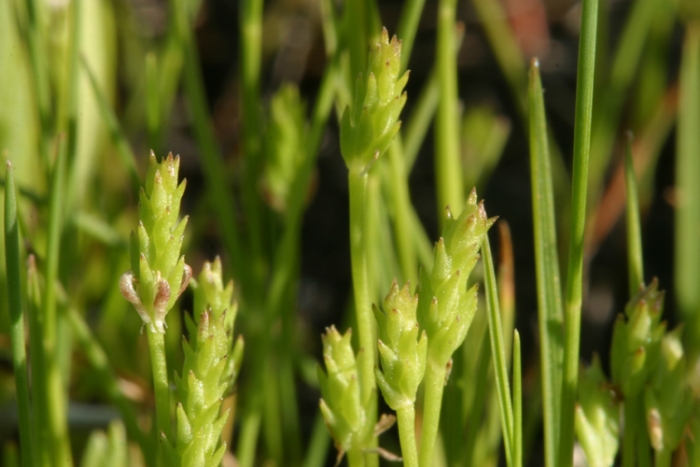Bristly Mousetail
(Myosurus apetalus)
Bristly Mousetail (Myosurus apetalus)
/
/

© Steve Matson
CC BY 4.0
Image By:
© Steve Matson
Recorded By:
Copyright:
CC BY 4.0
Copyright Notice:
Photo by: © Steve Matson | License Type: CC BY 4.0 | License URL: http://creativecommons.org/licenses/by/4.0/ | Uploader: matsonburger | Publisher: iNaturalist |

























Estimated Native Range
Summary
Myosurus apetalus, commonly known as Bristly Mousetail, is an annual herb native to moist and wet habitats including marshes, meadows, vernal pools, and streambanks in western North America and parts of South America, including Chile. It is a diminutive plant, typically forming a small tuft no more than 5 inches tall. The narrow, linear leaves can reach up to 2 inches in length. Bristly Mousetail is characterized by its unique inflorescence, which consists of a single flower with an elongated, cylindrical or cone-shaped receptacle that can be up to 1 inch long, surrounded by small greenish sepals. The plant lacks petals, which is a distinctive feature. Flowering occurs in the spring and early summer.
This plant is valued for its unusual appearance and is often used in native plant gardens, rain gardens, and as part of wetland restoration projects due to its preference for moist environments. It requires consistently wet or moist soil conditions and can tolerate a range of light conditions from full sun to partial shade. While not commonly found in traditional garden settings, Bristly Mousetail can be an interesting addition to a garden that aims to replicate a natural wetland or marsh habitat. It is relatively low-maintenance, but gardeners should ensure that the soil does not dry out. There are no significant disease or pest issues associated with this plant, but it may not compete well with more aggressive species.CC BY-SA 4.0
This plant is valued for its unusual appearance and is often used in native plant gardens, rain gardens, and as part of wetland restoration projects due to its preference for moist environments. It requires consistently wet or moist soil conditions and can tolerate a range of light conditions from full sun to partial shade. While not commonly found in traditional garden settings, Bristly Mousetail can be an interesting addition to a garden that aims to replicate a natural wetland or marsh habitat. It is relatively low-maintenance, but gardeners should ensure that the soil does not dry out. There are no significant disease or pest issues associated with this plant, but it may not compete well with more aggressive species.CC BY-SA 4.0
Plant Description
- Plant Type: Herb
- Height: 0.1-0.5 feet
- Width: 0.1-0.2 feet
- Growth Rate: Slow
- Flower Color: Green, White
- Flowering Season: Spring
- Leaf Retention:
Growth Requirements
- Sun: Full Sun
- Water: Medium
- Drainage: Medium, Fast
Common Uses
Low Maintenance, Potted Plant, Rock Garden
Natural Habitat
Moist and wet habitats including marshes, meadows, vernal pools, and streambanks
Other Names
Common Names: No Petal Mousetail, Mousetail, Sedge Mousetail
Scientific Names: , Myosurus apetalus, Myosurus aristatus, Myosurus aristatus var. apetalus, Myosurus aristatus var. brachypodus, Myosurus aristatus var. gracilis, Myosurus aristatus var. typicus, Myosurus gracilis, Myosurus minimus var. aristatus, Ranunculus aristatus,
GBIF Accepted Name: